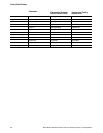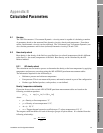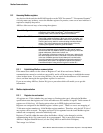
68 Micro Motion 7829 Viscomaster
®
and Viscomaster Dynamic
™
Viscosity Meters
Modbus Communications
D.2 Accessing Modbus registers
Any device which can drive the RS-485 interface on the 7829 Viscomaster
®
/ Viscomaster Dynamic
™
viscosity meter can, in theory, access the Modbus registers. In practice, some sort of user interface is
required to simplify the process.
ADView offers several ways of accessing the registers.
D.2.1 Establishing Modbus communications
If the meter Slave address or the values of Registers 47 and 48 are not known, Modbus
communications cannot be carried out successfully, and it will be necessary to establish the current
values in these items. If you are using ADView, you can search for the addresses of all connected
slaves, and then interrogate the appropriate registers for each one.
If you are not using ADView, Section D.6 gives a procedure which will enable you to get this
information.
D.3 Modbus implementation
D.3.1 Register size and content
All registers are 32 bits (whether they are integer or floating point types), although the Modbus
specification states that registers are 16 bits and addresses and ‘number of register’ fields assume all
registers are 16 bits long. All floating point values are in IEEE single precision format.
Registers are contiguous in the Modbus register ‘address space’. There is a one-to-one mapping of
32-bit meter register numbers to 16-bit Modbus register numbers. Therefore, only the full 32 bits of
any register can be accessed. The upper and lower 16-bit segments have the same Modbus register
number and consequently cannot be individually read.
Registers 47 and 48 within the meter allow the Modbus ‘dialect’ to be changed to suit the
communicating device if it cannot easily be re-programmed. This is most easily done using
ADView’s Register Read/Write tool (see the Using ADView and ProLink II chapter).
Their usage is as follows:
Board Configuration:
A graphical interface for viewing and setting the main configuration
parameters of the 7829 Viscomaster
®
/ Viscomaster Dynamic
™
viscosity meter. Direct access to registers is not offered.
Register Read/Write
This tool provides a simple window from which to read and write to
named and numbered registers. When you write to a register, you
are presented with a set of allowable values from which to choose.
Thus the tool is only useful for communicating with Micro Motion
meters. This is the simplest and most foolproof way of directly
accessing the registers. Section 4 gives full details.
Direct Communications
This is another tool which allows you to compose a sequence of
data to be transmitted to/from the Modbus. This can be used to
communicate with any Modbus device, providing that you know the
register addresses, data format, indices, etc.
The composition of the data is entirely up to the user, although the
tool does compute and insert a checksum. Only those well versed
in the use of Modbus protocol should attempt to use this facility.
It is mainly designed for testing Modbus transmissions which are
subsequently to be used in an application specific environment.
A worked example of using this tool is given in section D.7.


















